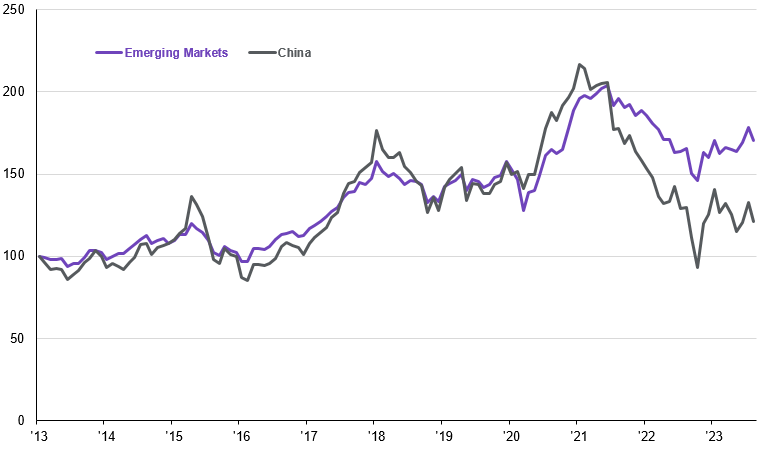Written by: Gabriela Santos and Mary Park Durham
For the past decade, China’s equity market performance influenced the broader emerging market (EM) universe, both directly and indirectly. However, this year is a different story. It may surprise investors to realize that EM ex-China equities are up 8.7% despite Chinese equities being down 7.1%. Why have other EM markets not followed the downward trend in Chinese markets? Structural and cyclical themes are providing tailwinds: supply chain shifts, semiconductor and AI enthusiasm, growing commodity demand and easing monetary policy cycles. While opportunities still exist in Chinese markets, investors can participate in other themes by investing in a broader EM universe.
Structural and cyclical themes are providing tailwinds to other EM markets, including:
- Supply chain shifts: Given geopolitical tensions and changes in relative manufacturing wages, companies are rethinking their production by focusing on “nearshoring” and “friendshoring”. Earlier this year, Mexico surpassed China to become the U.S.’s largest import partner for the first time since 2002 and has seen double-digit foreign direct investment growth. The excitement about “nearshoring” has benefited Mexican equity markets and the peso, up 21.4% and 13.5%, respectively, year-to-date. In Asia, India and Vietnam are making “friendshoring” more appealing by investing in new infrastructure projects and offering competitive corporate tax rates. Combined with a cyclical upturn, this theme has been a tailwind for Indian equities, up 9.9% this year.
- Semiconductor and AI enthusiasm: U.S. semiconductor companies are up 40.4% this year, due to AI enthusiasm and the expectation of a cyclical turn in the market. This is a theme that also benefits EM markets like Taiwan and South Korea, which produce approximately 67% of semiconductors globally and almost all of the more advanced ones. This has propelled these markets higher this year, up 14.9% and 11.8%, respectively.
- Growing commodity demand: South American mines have roughly 34% of the world’s copper and 36% of the world’s lithium, while Indonesia and the Philippines produce 42% of the world’s nickel, all key inputs for clean energy technologies. A growing global population means rising demand for food. LATAM’s agricultural trade balance is estimated to reach USD 73 billion by 2029 (OECD estimates), the largest for any region in the world.
- Easing monetary policy cycles: Some EM central banks were particularly early and aggressive in the battle against inflation. LATAM central banks began raising rates a year before those in developed markets. As a result, inflation is now close to target and some central banks in the region have begun their easing cycles. This should provide cyclical support to these economies and, most importantly, lead to a flow away from bonds and toward equities by local investors. This has helped LATAM to be one of the best performing equity regions globally, up 15.4% this year.
While what happens in China will continue to influence growth, sentiment, and performance in the broader EM universe, powerful structural and cyclical themes can lead to differentiated performance. These themes can benefit consumer, industrial, technology, financial and commodity companies in EM ex-China. Investors can participate in these opportunities by diversifying emerging market exposure with a focus on the potential beneficiaries.
Emerging market returns are not following China's downward trend this year
Jan. 2013 = 100, total return, local currency, monthly
Source: FactSet, MSCI, J.P. Morgan Asset Management. Emerging Markets = MSCI Emerging Markets Total Return Index, China = MSCI China Total Return Index. Data are as of September 12, 2023.



